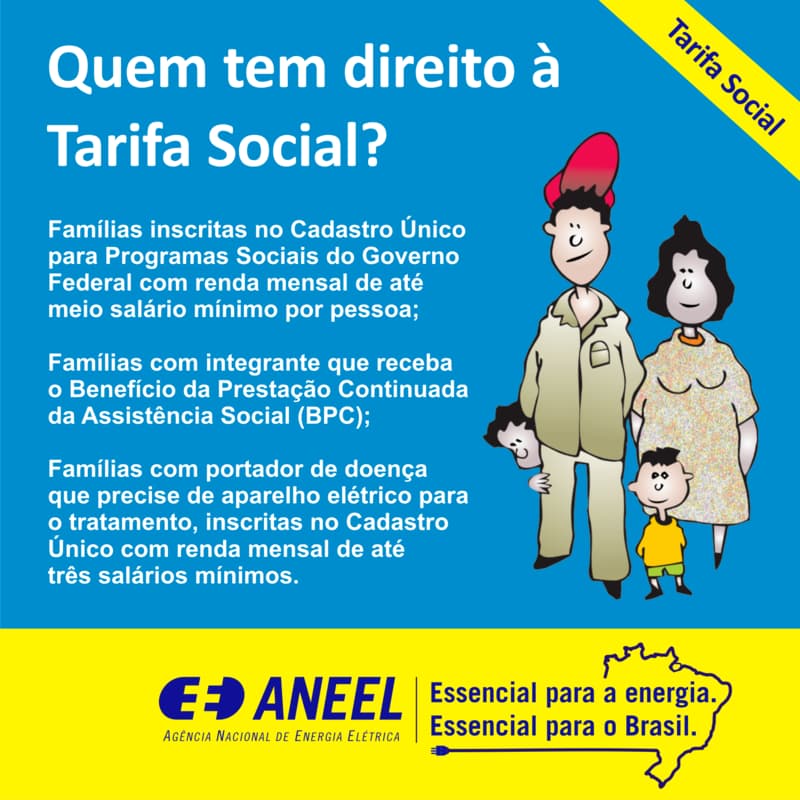Social Energy Tariff: how does it work?
The social energy tariff is government assistance aimed at families with very low incomes, who may have difficulty paying their energy bills.
Basically, discount bands are established on the energy bill according to the amount of consumption.
The lower the total energy consumed, the greater the discount that will be applied to your energy bill.
However, not everyone will have access to this benefit, as we will see.
Who can apply for the social tariff
The law that established the social tariff provides for some very specific cases in which citizens are entitled to this right.
Check below if your family fits into any of the cases:
- Registered in the Single Registry for Social Programs of the Federal Government, with per capita income less than or equal to half minimum wage;
- Registered for the Continuous Social Assistance Benefit – BPC, in accordance with articles 20 and 21 of Law No. 8,742/93;
- Family with a person with an illness or disability that requires the use of electricity, provided they are registered in the Single Registry with a monthly income of up to 3 (three) minimum wages.
Below, we will see what you must do to apply for the social tariff, if you meet any of the above requirements.
How to apply for the social tariff
To be eligible for the social energy tariff, in addition to meeting the requirements we have shown, the interested party must request the energy company in the region to classify their residence as low income residential.
Check the procedures in more detail on the website of your state's energy distributor. Here on the website, we show you how to contact the main energy distributors in the country.
Click on the links below and access the website of your state's operator:
Once the request has been made, your family will be entitled to the benefits of the social energy tariff.
If the company does not comply with your request for social registration, you can make a complaint to ANEEL, which is the National Electric Energy Agency.
This agency exists precisely to regulate the Brazilian energy system, preventing abuses by distributors.
To find out how to register a complaint to ANEEL, click on the link.

Social tariff discounts
The discounts provided for in the social energy tariff law are based on energy consumption bands. The idea behind this law is to benefit low-income families who use little electricity in their homes.
See below the discounts you can get through the social tariff:
- Consumption of up to 30 KWh: discount of 65%
- Consumption between 31 KWh and 100 KWh: discount of 40%
- Consumption between 101 KWh and 220 KWh: discount of 10%
- From 221 KWh, no discount will be applied to the invoice
This way, the discount will be greater for those families that use less energy at home.
Discount for indigenous and quilombola families
The law specifically provides for a discount for indigenous and quilombola families who use little electricity. In these cases, if the family consumes less than 50 KWh in the month, an energy bill will not even be generated: these families will receive a discount of 100% on their electricity bill.
If the indigenous or quilombola family exceeds the monthly consumption of 50 KWh, the discount bands presented above must be observed.
Bill – Discount up to 70%
We will probably see some changes to the social energy tariff. In April 2019, the Senate approved a bill that increases discounts for each energy consumption band.
New discounts must follow the rules below:
- Consumption up to 50 KWh: discount of 70%
- Consumption between 51 KWh and 150 KWh: discount of 50%
- Consumption between 151 KWh and 250 KWh: discount of 20%
- From 252 KWh onwards, no discount will be applied to the invoice
For this project to come into force, it still needs approval from the Chamber of Deputies and sanction from the President of the Republic, so take a look at the values we show first in this article.



